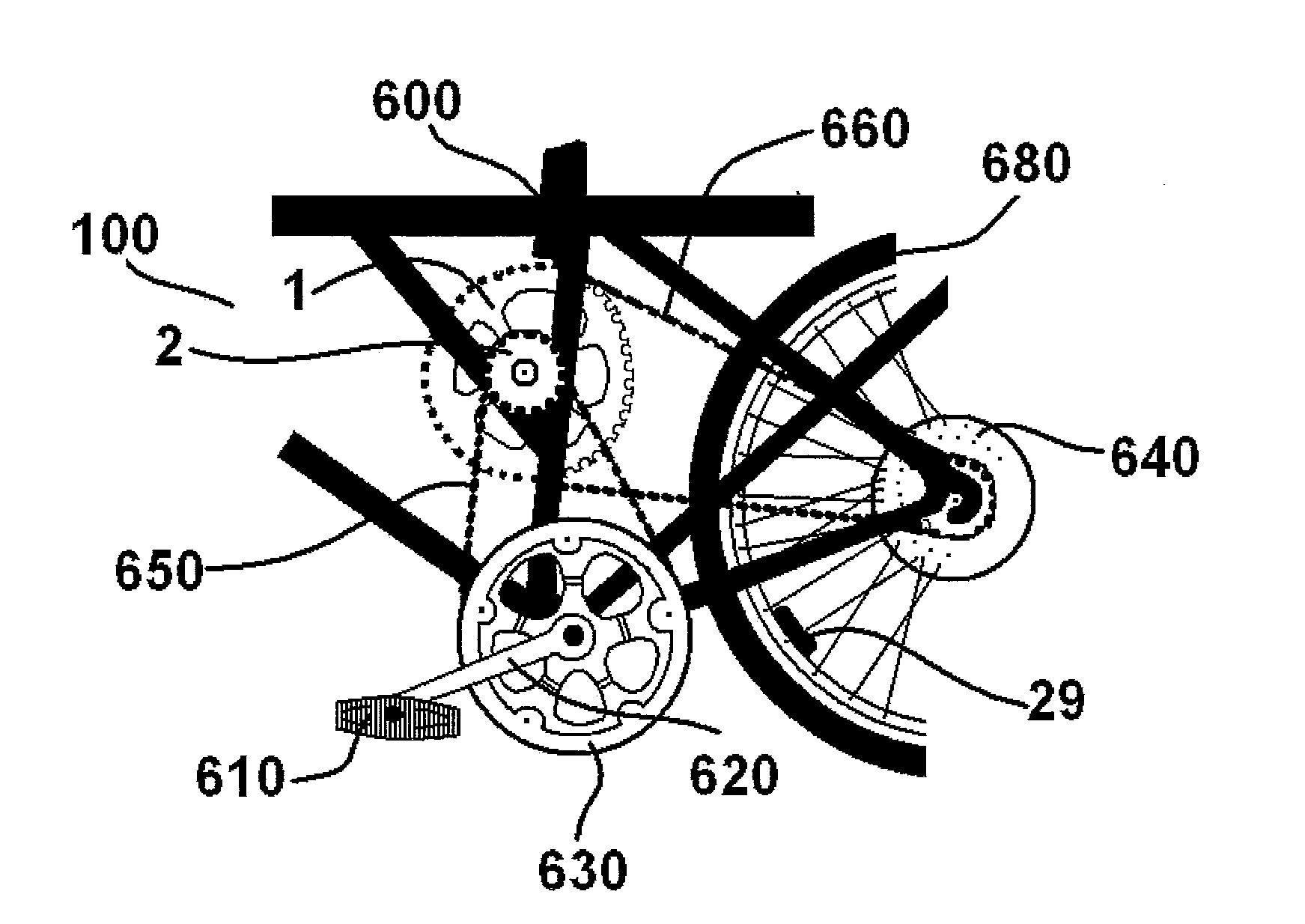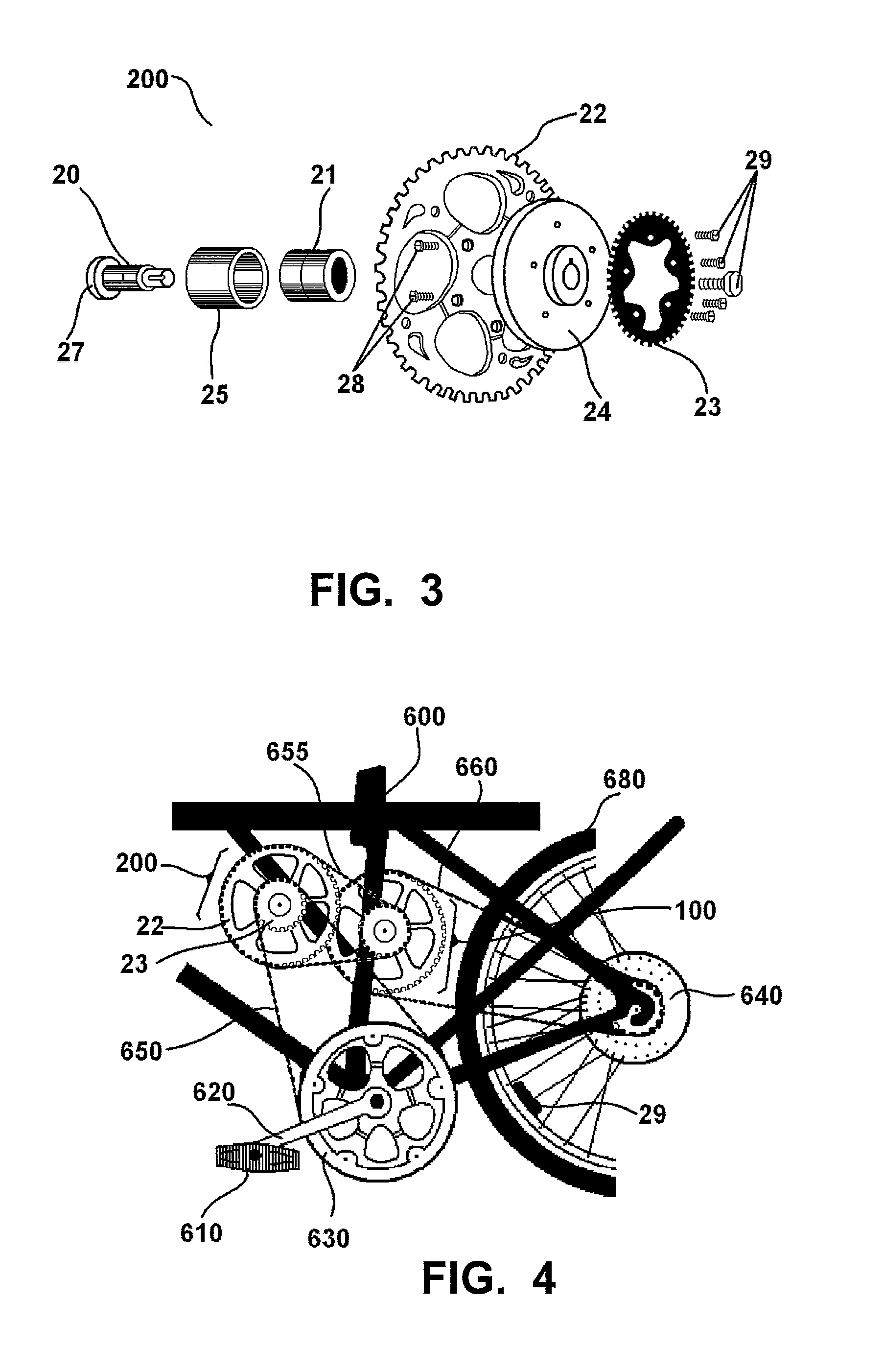Drive System for Vehicle
a technology for driving systems and vehicles, applied in the direction of vehicle transmission, rider propulsion, chain/belt transmission, etc., can solve the problems of poor performance, significant maintenance cost, and position of pedals, and achieve the effect of high initial speed, short time, and constant speed
- Summary
- Abstract
- Description
- Claims
- Application Information
AI Technical Summary
Benefits of technology
Problems solved by technology
Method used
Image
Examples
first embodiment
[0035]For a better understanding of the invention, the principles of the same applied to a human-powered vehicle, especially on a bike, are described herein. Thus, in the invention, illustrated in FIGS. 1 and 2, the drive shaft 100 is composed of two sprockets, one with a great diameter 1 and another one with a diameter less than the other 2 (or equivalently, with fewer teeth), two support hubs 3 and 4 on which the sprockets 1 and 2 are fixed, respectively, by fasteners 13 and 14; two bearings 5 inserted inside a bearingholder 6. A shaft 7 with a diameter equal to the diameter of the bearings 5, to which are tightly coupled, under pressure, taking the shaft 7 a length divided into three sections, namely, a central part 8 which supports the bearings 5 and two ends 9 and 10 of smaller diameter which serve to cap and support the support hubs 3 and 4 joined with the two sprockets 1 and 2, where the function of the support hubs 3 and 4 support is to keep the sprockets 1 and 2 perpendicul...
third embodiment
[0042]the present invention comprises a drive shaft 300, which by its assembly allows a different configuration to the above mentioned embodiments; FIG. 5 illustrates the components of the drive shaft 300 that consists of 5 elements and fixing means 31, such as screws. The central section of the shaft 30 is of the same diameter as of the inside diameter of the bearings 32 which have a separator between them, to provide greater stability to them in response to the pressure at which they are submitted; said shaft 30 in its first section 36 has a length which enables it to couple with the inside part of the bearings 32, these bearings 32 being received within the bearingholder 33 which help supporting the force applied to start the vehicle movement. Also, at the far end of the shaft 30 is located a smaller diameter section 34 at the end of which has a keyway 35 to hold and avoid slippage of the pair formed by the larger sprocket 38 and the smaller sprocket 37; continuous to the smaller...
embodiment 1
II. Embodiment 1 with the Drive Shaft 100
[0064]Since the movement provided by the rider to pedal and transmitted by him to the central star 630 is transmitted to the smaller sprocket 2 of the drive shaft 100 via chain 650, as illustrated in FIG. 2, the first transmission relationship is produced between these two elements 630 and 2; the smaller sprocket 2 then turns to the larger sprocket 1 in a direct link through the shaft 7, and the larger sprocket 1 finally transmits motion to the pinion gear 640 by chain 660, setting the second transmission ratio 1-640, so we have:
[(N630n2)*(N1n640)](6)
which can be rearranged to:
[(N630n640)*(N1n2)](7)
so the vehicle speed would be increased, keeping other factors constant, in an amount equal to the ratio between the number of teeth on the smaller sprocket 2 and the number of teeth on the larger sprocket shaft 2 of the drive shaft 100 intermediate to the central star 630 and the pinion gear 640 that moves the wheel 680. It is said that there is a...
PUM
 Login to View More
Login to View More Abstract
Description
Claims
Application Information
 Login to View More
Login to View More - R&D
- Intellectual Property
- Life Sciences
- Materials
- Tech Scout
- Unparalleled Data Quality
- Higher Quality Content
- 60% Fewer Hallucinations
Browse by: Latest US Patents, China's latest patents, Technical Efficacy Thesaurus, Application Domain, Technology Topic, Popular Technical Reports.
© 2025 PatSnap. All rights reserved.Legal|Privacy policy|Modern Slavery Act Transparency Statement|Sitemap|About US| Contact US: help@patsnap.com



